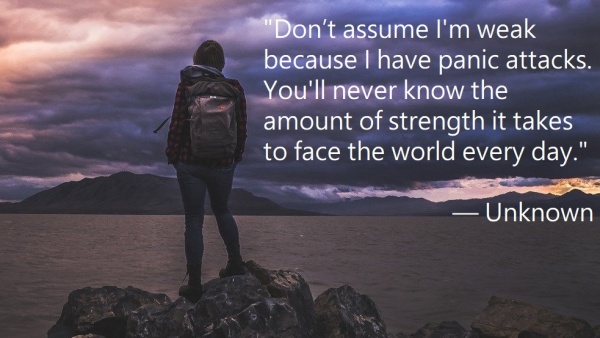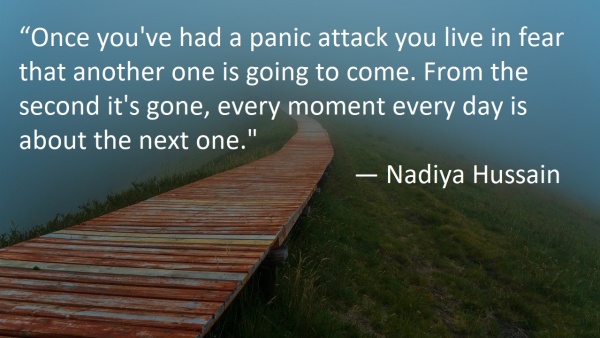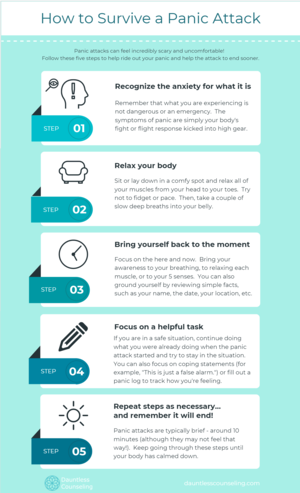Panic attacks are one of the more uncomfortable experiences that can happen in the human body. If you would like to know more about panic attacks and how to survive them, keep reading!
Table of Contents
What Does a Panic Attack Look Like?
So first, how do you know that you are having a panic attack? Here are some common signs and symptoms (which may vary, depending on the individual):
- Excessive sweating (not due to heat or exercise)
- Shakiness
- Dizziness
- Pounding or fast heart rate
- Feeling like you are choking
- Pain or pressure in your chest
- Nausea or upset stomach
- Feeling lightheaded or faint
- Numbness or tingling
- Chills or feeling suddenly hot
- Feeling like you can’t get enough air or catch your breath
- Feeling like you are going to lose control or “go crazy”
- Feeling like your surroundings aren’t real
- Feeling like you aren’t real
- Feeling like you might die
It’s important to remember that none of these symptoms are a sign that something is going wrong in your body. Each one of these is due to a specific physiological change that is your body’s way of trying to keep you safe from danger.
For example, when your body believes that you are in danger, it will speed up your heart rate and breathing rate in order send more oxygen-rich blood out to your arms and our legs. This in turn helps your body be more ready to run away or fight back against the danger. Unfortunately, when there is no real danger these symptoms go from being helpful to being uncomfortable and paradoxically unhelpful.
All of this being said, if you have not done so already, it is important to check in with your physician to make sure that you do not have any underlying physical conditions. Once you have established that you do not, you can be assured that these symptoms are caused by anxiety.

Why Do People Panic?
Panic is nothing more or less than your body’s fight, flight or freeze system kicking into full gear. The real problem is that it is being activated when there really isn’t anything dangerous going on. For example, if you were to experience a “panic attack” when a bear came charging at you, this would be viewed as a helpful and natural response. But if you were to experience the same internal experience due to a final exam, a social interaction, or even for no apparent reason at all, it would likely feel scary and unnatural.
Here is how anxiety can snowball into a panic attack:

Once someone starts to experience panic attacks, it is not uncommon to develop anxiety around possibly panicking in the future (i.e., “fear of the fear”). This can lead to more avoidance of possible situations that could potentially trigger a panic attack. Over time this can lead to missing out on activities that were once enjoyable, such as spending time with friends.
Lies Your Brain Will Tell You When You Panic
When you go into panic mode it can be easy to believe that the symptoms that you are experiencing are truly dangerous. Here are a few of the common myths about panic to be aware of and the reality behind them:
| Myth | Reality |
| That you will pass out or faint. | You are actually less likely to pass out during a panic attack due to a rise in blood pressure (fainting occurs when your blood pressure suddenly drops). |
| That you will suffocate or stop breathing. | You may experience a tight feeling in your throat due to increased muscle tension, but you will not suffocate. |
| That you are having a heart attack. | During a panic attack you may experience chest pain due to increased muscle tension. |
| That you will lose control. | You are still in charge of your actions during a panic attack. |
| That you are going to go crazy. | The fight, flight, or freeze response is a natural part of your survival brain. |
| That you are dying. | No one has ever died from a panic attack. |

The steps you can take to get through a panic attack
So now that you know a little bit about what is actually going on and why you are experiencing panic, let’s talk about some steps you can take to help make your panic attacks a little more bearable.
Five Steps to Help Get Through a Panic Attack:
Let’s talk about each of these steps in a little more detail.
1. Recognize the anxiety for what it is…and remember that it won’t kill you!
This may sound like an extreme statement, but often times my patients will talk about how it feels like they are dying or having a heart attack when they are having a panic attack. Panic attacks are incredibly uncomfortable (to put it mildly), but our bodies are designed to handle everything that occurs during a panic attack.
Remember that fighting the anxiety by trying to deny what’s happening or trying to make the anxiety go away will only make your anxiety worse.
2. Relax your body.
And you’re thinking, “How the heck am I supposed to do that?! I’m panicking!” I know this may sound like an absurd suggestion, but it’s not about feeling relaxed, it’s about physically relaxing your body as much as possible.
- First, make sure that you are sitting or standing in a relaxed position. Often the urge is to pace or move around a lot. This can actually make your anxiety worse due to your body sending signals to your brain that you are moving around because there is real danger that you are trying to escape from.
- Second, take note of any tension in your body that you could try to let go of. For instance, is your jaw clenched? Are your shoulders scrunched up by your ears? Are your hands twisted up? Are you sitting ramrod straight or curled up tightly in a ball? Try to start with your face and check in with each part of your body all the way down to your toes to see if there’s a place you can relax a little bit more. Here is a video that can help to guide you in a Body Scan Meditation that may be helpful.
- Third, take some slow, deep breaths. Try to shift your breathing from your chest to your belly (i.e. your belly will go out as you breathe in, rather than your chest rising) and make your exhales at least as long as your inhales, if not longer. If you can, add a pause at the top of each inhale before you exhale. If it’s helpful, you can add counting to each step of your breath. For instance, breathe in for a count of 4, hold for a count of 7, and breath out for a count of 8 (also known as, 4-7-8 breathing).
3. Practice bringing yourself back to the moment.
If your mind has gone down a worry rabbit hole, try to focus on something simple and in the moment. Some examples could be:
- Focus on counting out the 4-7-8 breathing
- Focus on relaxing the different muscles in your body
- Focus on your 5 senses (what you can see, hear, and feel around you)
- Focus on concrete facts (such as your name, the date, where you are, what you were doing before you panicked, etc.) Check out this article on grounding for more ideas.
4. Focus on a helpful task.
If you act as if there is no danger, then this will help your body to realize that there is no danger. This in turn will help your body to calm down.
If you can stay in the situation you were in when you started to panic and continue whatever task you were doing, this can be one way of letting your body know that there is nothing it needs to protect you from. Of course, this only applies if you are actually in a safe situation!
Here are examples of tasks that might be helpful to focus on if you are panicking:
- Continue to do what you were doing when you started to panic (for instance, if you were making dinner, see if you can continue to make dinner or if you were watching a movie, continue watching the movie).
- Use coping statements that you find helpful. Some examples might include:
- “Although these feelings are uncomfortable, they’re not dangerous.”
- “This is just a false alarm.”
- “This isn’t an emergency. It’s okay to think slowly about what I need to do.”
- “I’ve survived this before and I’ll survive this time too.”
- “I can do my coping strategies and allow this to pass.”
- Fill out a panic log. Panic logs can give you a positive task to focus on, as well as give helpful information about your panic that you can use to help reduce your panic in the future.
Remember that there is no rush to get through any of these tasks! Panic is not an emergency, and you can take your time.
5. Repeat these steps as necessary and remember that it will end!
The human body is only able to sustain panic for a limited amount of time. While they may feel endless, most panic attacks last less than 10 minutes and the body does not have enough energy to panic for longer than 30 minutes. This means that eventually the panic attack will end!
Keep this in mind as you use the tools above until you have waited out your panic. The bottom line is that you are stronger than your panic and you will get through this!

How Can You Stop Having Panic Attacks?
This is the million-dollar question! Unfortunately, there is no quick fix for stopping panic attacks altogether. However, there are strategies that can help. Here are a few tips you can start with:
- Take time to take care of your physical health. This might include:
- Eating and sleeping regularly
- Regular exercise
- Reducing your caffeine intake
- Reducing stress (if possible)
- Practice daily mindfulness and relaxation. This might include:
- Deep breathing
- Meditation
- Yoga
- Bubble baths
- Time with pets
- Check out this article on Activities to Relax and De-Stress for more ideas
If you have tried these strategies and are not experiencing the desired relief, I would recommend seeking professional support. Over time, an increase in avoidance of certain activities or places due to anxiety can increase your panic. A therapist can support you in figuring out strategies to reverse this course and help you gradually reduce the anxiety related to your triggers.
One such strategy may be a certain type of intervention called interoceptive exposures. Interoceptives can help your body to get used to certain physiological sensations and therefore prevent anxiety from snowballing into panic. This technique is generally done with the support and supervision of a therapist as it is important to do interoceptives correctly in order to not aggravate your anxiety further.

If you suffer from panic, I hope this guide can help empower you to take back your life and get back to the things that you enjoy!
As a reminder, this blog post is not intended as professional counseling or clinical advice. This article is meant to help bring greater understanding regarding what panic might look like for you and how to cope with panic attacks. However, I encourage you to consider seeking help in person if you need additional support.

-Kristel Roper, LMFT, LPCC
Kristel Roper is a licensed psychotherapist offering counseling services to individuals in the Sacramento area. She specializes in anxiety counseling and especially enjoys working with young adults as they navigate the challenges of college, career, and beyond. Learn more about Kristel Roper’s Counseling Services.
